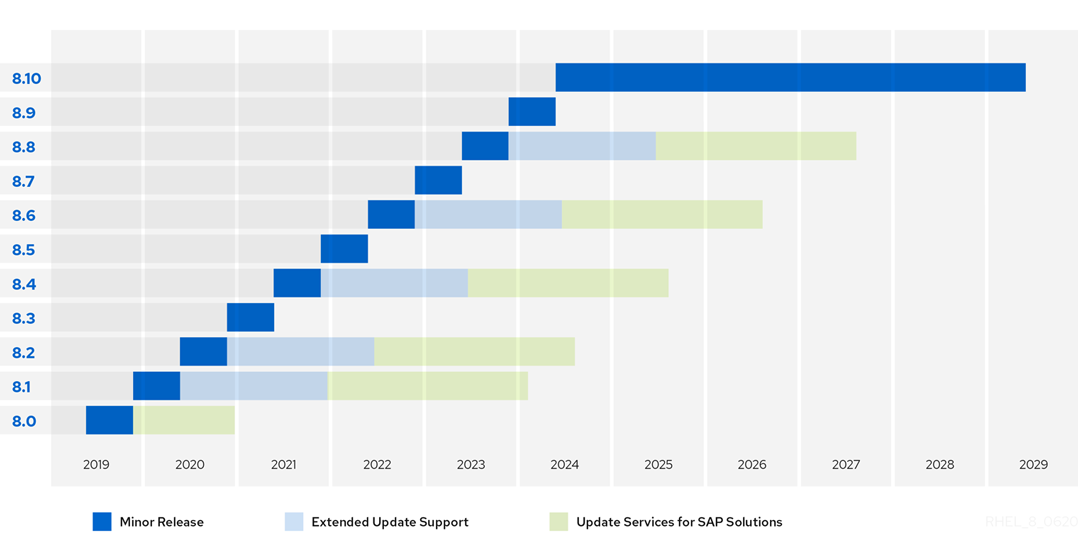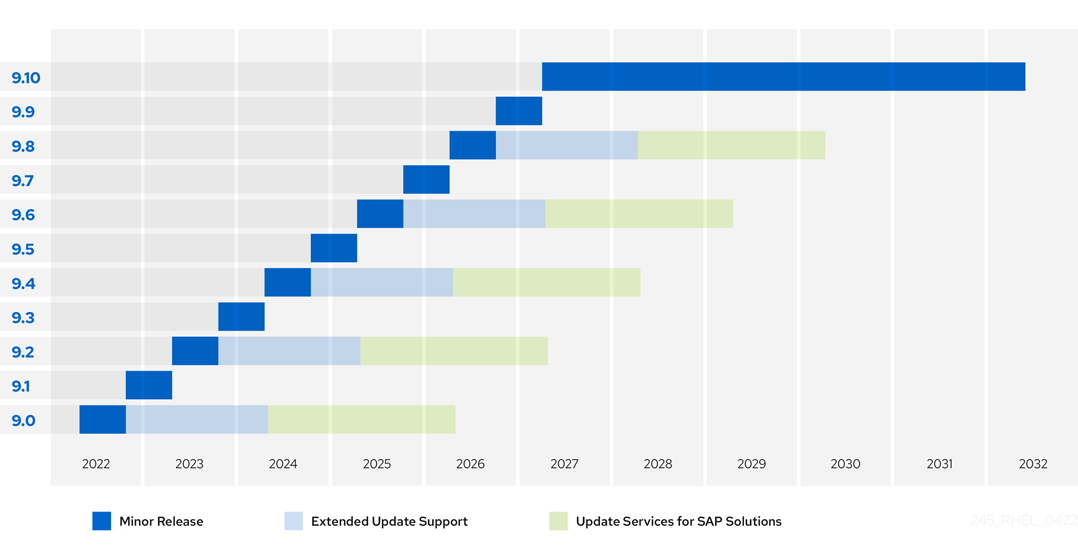Red Hat Enterprise Linux (RHEL) Extended Update Support (EUS) Overview
- What Is Extended Update Support (EUS)?
- What Customer Use Cases Benefit from Using EUS?
- How are updates to the EUS repository made?
- Recommended Red Hat Enterprise Linux Maintenance Practices
- How to Access EUS
- EUS Timing and Planning Considerations
- Upgrade Restrictions for EUS repositories
- Additional Reading
What Is Extended Update Support (EUS)?
Extended Update Support (EUS) is an optional offering for Red Hat Enterprise Linux subscribers. With EUS, Red Hat provides backports of Critical and Important impact1 security updates and urgent-priority bug fixes for a predefined set of minor releases of Red Hat Enterprise Linux. EUS enables customers to remain with the same minor release of Red Hat Enterprise Linux for 24 months, allowing for stable production environments for mission-critical applications.
EUS is provided with x86-64 Red Hat Enterprise Linux Server Premium subscriptions and is available as an Add-on to Red Hat Enterprise Linux Server standard subscriptions, Red Hat Enterprise Linux for IBM Power LE, and Red Hat Enterprise Linux for IBM z Systems subscriptions. EUS is now available for Red Hat Enterprise Linux Workstation standard and premium subscriptions as an Add-on for version 9 only. Please contact your Red Hat Sales Representative if you are unsure if you have access to EUS and to help decide if it is appropriate for your environment.
What Customer Use Cases Benefit from Using EUS?
- Customers who have a policy of re-certifying application stacks when they move to new minor releases of Red Hat Enterprise Linux
- Customers who have sensitive workloads that require minimal change
- Customers using third party applications from ISVs who certify on specific Red Hat Enterprise Linux minor releases
How are updates to the EUS repository made?
The inclusion criteria for fixes in the Extended Update Support repository will follow two general rules during its 24-month life cycle:
- 0-6 months: Includes generally the same errata released for the corresponding minor version with the exception of driver updates.
- 7-24 months: Only Critical and Important impact security updates and urgent-priority bug fixes. At Red Hat’s discretion, in limited, new features or hardware enablement may be added to the EUS maintenance streams.
These criteria were selected to reduce change to an environment and promote stability.
Recommended Red Hat Enterprise Linux Maintenance Practices
To obtain the maximum maintenance benefits from a Red Hat Enterprise Linux subscription, it is recommended practice for customers to upgrade to each minor release as they are released (e.g., 9.0 --> 9.1 --> 9.2).
How to Access EUS
Like all Red Hat Enterprise Linux maintenance, EUS is delivered via Red Hat Subscription Manager, where it is implemented as a mirror repository hierarchy (separate repository(s), for each minor release, along with the relevant set of child repositories).
With the introduction of Red Hat Enterprise Linux 8, content is distributed through the two main repositories: BaseOS and AppStream.
BaseOS
Content in the BaseOS repository is intended to provide the core set of the underlying OS functionality that provides the foundation for all installations. This content is available in the RPM format and is subject to support terms similar to those in previous releases of Red Hat Enterprise Linux.
AppStream
Content in the AppStream repository includes additional user space applications, runtime languages, and databases in support of the varied workloads and use cases. Content in AppStream is available in one of two formats - the familiar RPM format and an extension to the RPM format called modules.
RHEL EUS Example using x86-64 Architecture
Red Hat Enterprise Linux 8 Minor Release Repositories
- Red Hat Enterprise Linux 8 for x86_64 - BaseOS
rhel-8-for-x86_64-baseos-rpms- Red Hat Enterprise Linux 8 for x86_64 - AppStream
rhel-8-for-x86_64-appstream-rpmsRed Hat Enterprise Linux 8 EUS Repositories
- Red Hat Enterprise Linux 8 for x86_64 - AppStream - Extended Update Support
rhel-8-for-x86_64-appstream-eus-rpms- Red Hat Enterprise Linux 8 for x86_64 - BaseOS - Extended Update Support
rhel-8-for-x86_64-baseos-eus-rpmsRed Hat Enterprise Linux 9 Minor Release Repositories
- Red Hat Enterprise Linux 9 for x86_64 - BaseOS
rhel-9-for-x86_64-baseos-rpms- Red Hat Enterprise Linux 9 for x86_64 - AppStream
rhel-9-for-x86_64-appstream-rpmsRed Hat Enterprise Linux 9 EUS Repositories
- Red Hat Enterprise Linux 9 for x86_64 - AppStream - Extended Update Support
rhel-9-for-x86_64-appstream-eus-rpms- Red Hat Enterprise Linux 9 for x86_64 - BaseOS - Extended Update Support
rhel-9-for-x86_64-baseos-eus-rpmsEUS can be activated for individual systems by subscribing them to the matching EUS repository(s) and executing
subscription-manager release --set=x.ywhere "x.y" is the supported RHEL major and minor version that one desires. (Executesubscription-manager release --listfor the available list, and see the "Extended Update Support Add-on" section of the RHEL life cycle document for the list of active EUS versions.)Customers with an active EUS subscription will see EUS repositories in addition to the standard repositories via Red Hat Subscription Manager (RHSM). RHSM provides status, inventory, organization, and reporting on Red Hat subscriptions via:
- A hosted service on the Red Hat Customer Portal
- On-premise access through Red Hat Satellite
- Using Subscription Manager from a Red Hat Enterprise Linux system
A robust supported and documented API for RHSMWhen you purchase a subscription to a product, RHSM tracks which system(s) in your inventory are registered to the subscription. Registered systems are entitled to support services, as well as errata, patches, and upgrades from the Content Delivery Network (CDN).
EUS repositories are shown in RHSM, meaning customers will only see the repositories based on their particular system's hardware architecture and the major version of Red Hat Enterprise Linux that is installed. A system can be moved to an EUS repository(s) by changing the base repository in that system's repositories menu to an EUS repository(s).
EUS Timing and Planning Considerations
Please see the Red Hat Enterprise Linux Life Cycle document for the list of minor versions and their end dates.
Red Hat Enterprise Linux 8 minor releases that include EUS are planned for release based on the below planning schedule. Customers requiring longer maintenance should plan based on the below schedule per the RHEL Life Cycle Policy.

Click here for larger version of graphic
Red Hat Enterprise Linux 9 minor releases that include EUS are planned for release based on the below planning schedule. Customers requiring longer maintenance should plan based on the below schedule per the RHEL Life Cycle Policy.

Click here for larger version of graphic
The RHEL EUS release repository receives all ALL security, bug fix, and enhancement errata (per the full maintenance RHEL life cycle policy) until the next minor release is released. Afterwards, it only receives the selected backports as per the EUS inclusion policy.
NOTE: The standard base repository (such as the Red Hat Enterprise Linux 9 for x86_64 - BaseOS) is mutually exclusive with any EUS repositories (i.e., an individual system may only be subscribed to the standard base repository or to an EUS repository, but not to both simultaneously). Once a system has been subscribed to an EUS repository, it will receive only EUS errata updates.
Upgrade Restrictions for EUS repositories
Customers who have systems subscribed to EUS repositories should be aware that there are upgrade restrictions when upgrading between minor releases (i.e., systems subscribed to a certain EUS repository should always be upgraded to either a later, more recent EUS repository or to the base repository for that version of Red Hat Enterprise Linux). For example, if a system is currently subscribed to the EUS 9.1 repository, at any time its subscription could be upgraded to:
- The RHEL 9.2 EUS repository after the release of 9.2
- The RHEL 9.4 EUS repository after the release of RHEL 9.4
- Any RHEL 9.y EUS repository where y is an even number
- The standard base repository for Red Hat Enterprise Linux 9, which is the most recent minor release.
WARNING: It is unsafe to downgrade from a more recent minor release with a higher version number to an earlier minor release or an earlier EUS repository. For example, it would be unsafe to downgrade from Red Hat Enterprise Linux 9.2 to 9.1.
EUS repository Deactivation
For a given RHEL minor release, EUS repository (for example RHEL 9.0), like all EUS repositories, will be retired 24 months after it is created and becomes available via Red Hat Subscription Manager. When an EUS repository reaches retirement, no new errata are released to the repositories. However, all previously released errata remain available to customers with an active subscription. It is imperative to migrate to a later EUS release to continue receiving errata updates like security and bug-fix errata. You can check to see which EUS repositories have been retired and are no longer receiving updates by looking at the Red Hat Enterprise Linux Retired Life Cycle Dates page.
More information on EUS and the Red Hat Enterprise Linux Life Cycle can be found on the Red Hat Customer Portal.
EUS Maintenance Policies
Please visit the Red Hat Enterprise Linux LIfe Cycle page for information on EUS maintenance policies.
Visit the Red Hat Customer Portal for more information regarding Red Hat Enterprise Linux subscriptions and base and child repositories.
Additional Reading
While EUS provides a more restrictive selection of errata, it does not provide an operational framework or discipline as to how a user of EUS can implement an errata management solution to support a rigid life cycle for their Red Hat Enterprise Linux systems. This is covered in the Red Hat Satellite Content Management Guide.
Red Hat Enterprise Linux 8 EUS Frequently Asked Questions
Red Hat Enterprise Linux 9 EUS Frequently Asked Questions
-
Applies to Important CVEs that occur on or after October 1, 2019 ↩︎


Comments